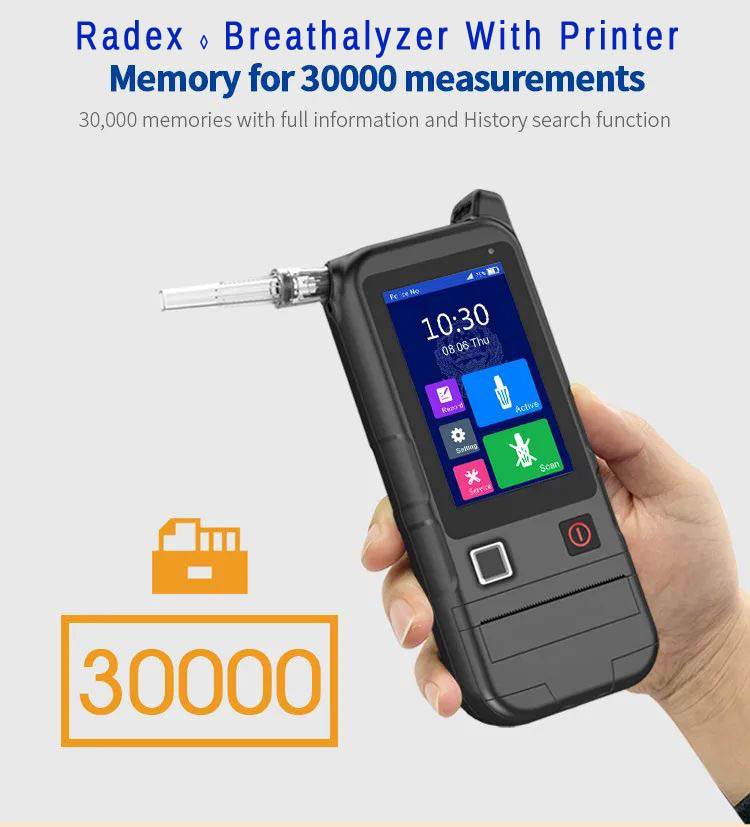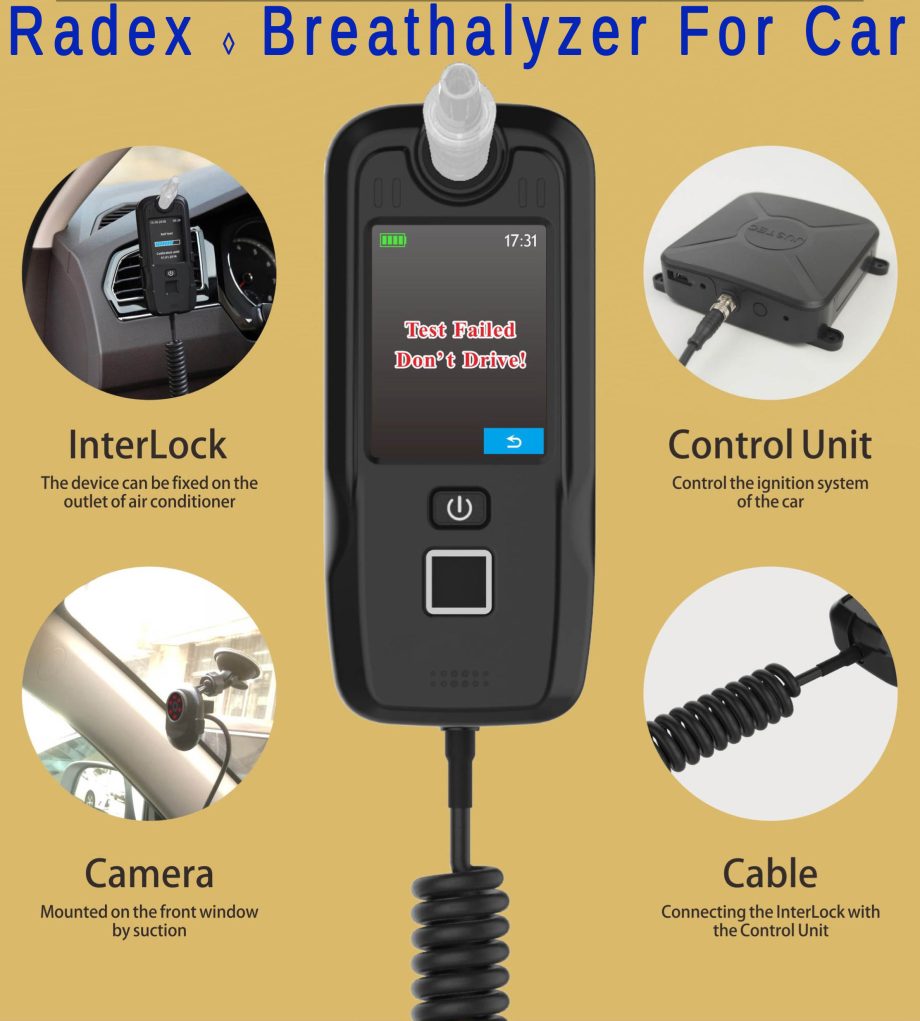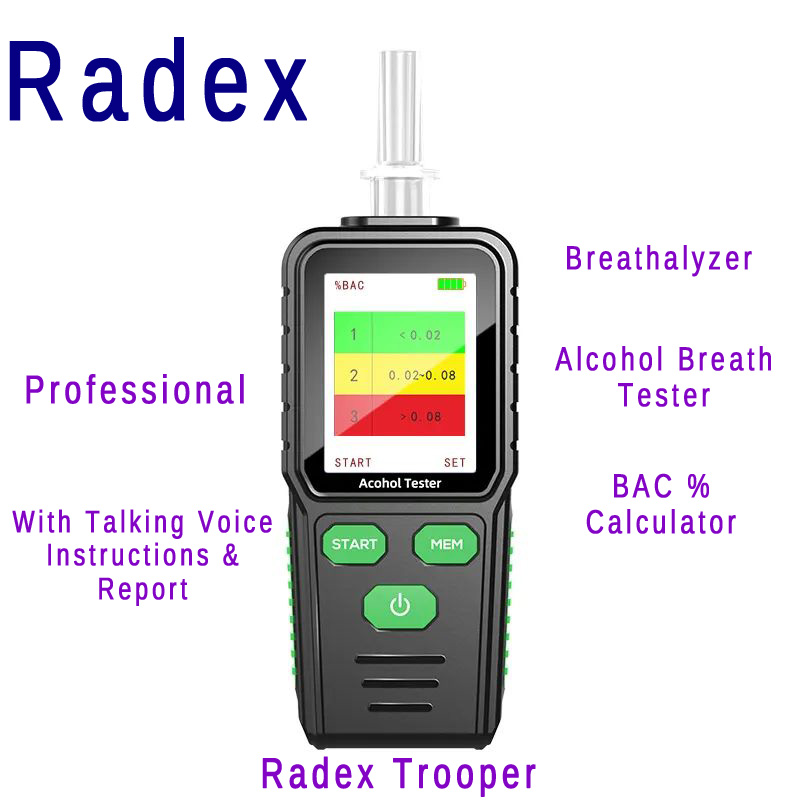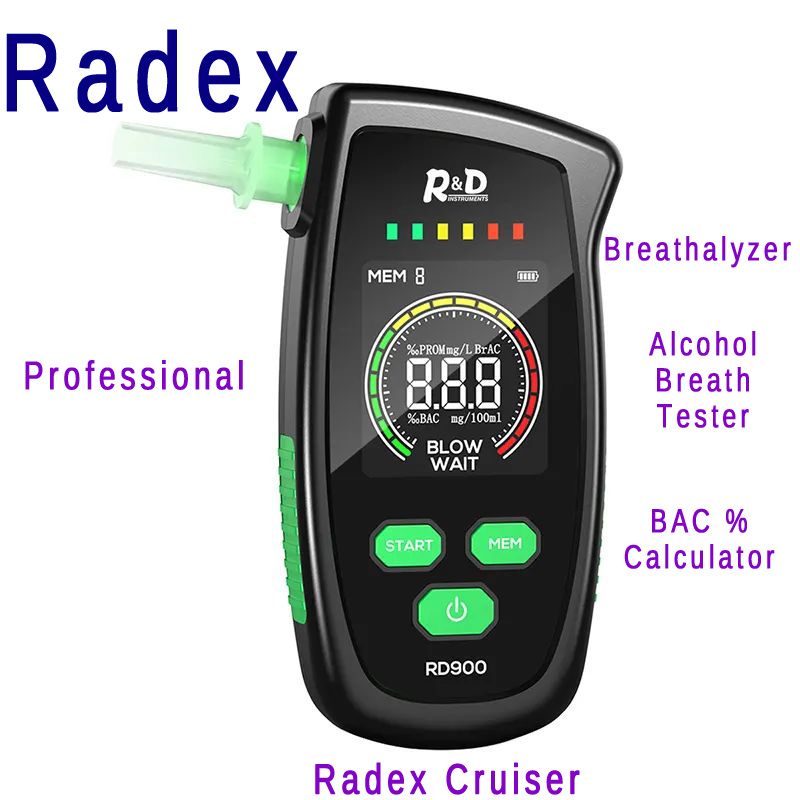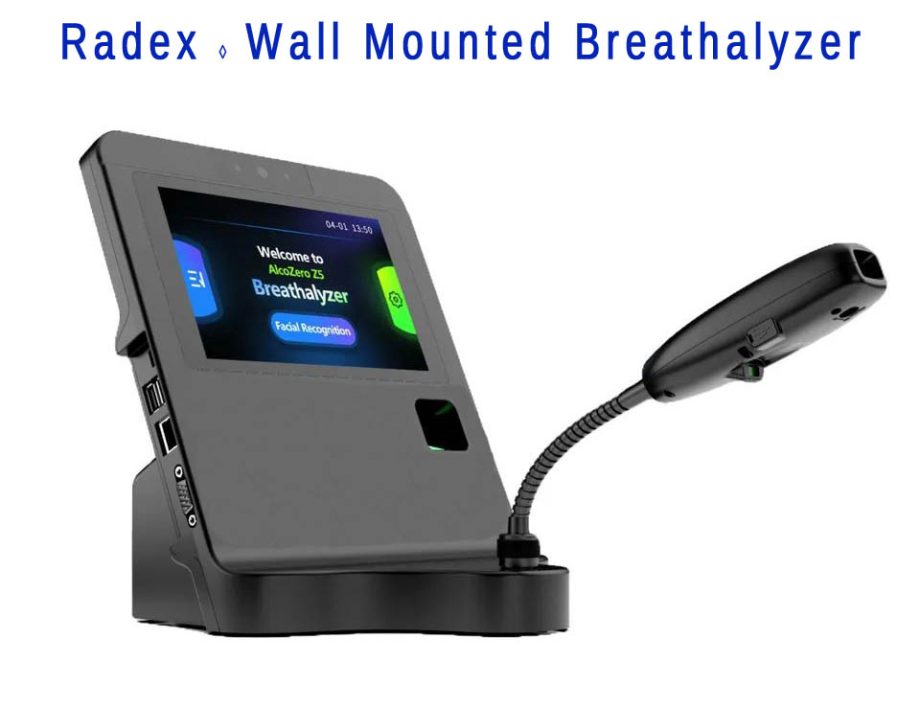-
Alcohol Breath Analyser With Printer
$499.95 -
Baiid Interlock Device
$899.95 -
Radex Alcohol Breath Tester
$89.95 -
Radex Breathalyzer
$69.95
How to Beat the Breathalyzer Test in a DUI Case
Breathalyzers are devices designed to measure the level of alcohol in your breath. They are commonly used as an early indicator that someone has exceeded the legal drinking limit to drive legally. Breathalyzers use potassium dichromate solution to test for alcohol. A photocell records any changes in color change that take place, then converts this data to determine an individual’s blood alcohol concentration (BAC).
What is a Breathalyzer Test?
Breathalyzers are used by police officers when investigating suspected DUI offenses to measure your blood alcohol content (BAC). It often serves as the initial step prior to requiring blood or urine tests at their stations. The test is performed using a device roughly the size and shape of an old-school mobile phone. You blow into a mouthpiece to collect breath samples that enters the device. From these, levels of ethanol in your breath are measured against standard solutions; then displayed digitally on an LCD readout as percentages that indicate your BAC; generally one green band indicates you are under legal limits for driving while two green bands indicates between 0.025%-0.08% while three green bands indicates your blood alcohol concentration has exceeded this limit and you are potentially intoxicated.
Breathalyzer tests can be accurate but aren’t 100 percent reliable. Many factors can skew results, including blood, vomit, food debris and chemicals in your mouth as well as factors like temperature of mouth temperature, breathing patterns and other environmental variables affecting results; some medical conditions even produce false positives that make these results inaccurate.
However, you can help ensure the results of your breathalyzer are unaffected by these common issues. For instance, to avoid false positive results in tests when smoking cigarettes or drinking tea prior to taking one can release acetone which could trigger false positive results on breathalyzer tests. Control your breathing, and breathe deeply to make sure the device measures alcohol in your lungs rather than mouth. Furthermore, never refuse a breath test at a checkpoint or traffic stop! Many states stipulate that if you refuse a test, your driver’s license will be suspended, making it more difficult for you to access work, school and caring for family. You may be able to fight your charges by showing that the results from your breathalyzer were false; this may convince a judge to drop them altogether.
How Does a Breathalyzer Test Work?
Breathalyzer tests are portable instruments used by law enforcement during DUI stops to measure someone’s blood alcohol content (BAC), with any level over 0.08 being illegal in every state. Testing must be administered by someone trained to operate the machine. The machine works by detecting an airborne chemical known as ethanol. Ethanol is a volatile compound produced when people exhale, so an infrared cell monitors expired breath to detect peak concentrations of this compound in the air. Once an adequate level has been identified by the machine, testing stops.
Before the person blows into a device, they are typically asked to rinse their mouth with water in order to eliminate any food debris or mouthwash residue that could interfere with results. After two minutes have passed, they are then retested to make sure any mouth alcohol has subsided.
Once a sample has been analyzed, the machine displays the result on an LED display for reading by an operator to ascertain if their blood alcohol concentration (BAC) level exceeds legal limit. Furthermore, an audible beep from the machine alerts him or her of potential errors during processing.
Breathalyzers may seem reliable, but certain factors can still cause them to fail or give false positive results. Drugs or medical conditions such as diabetes that causes ketones to build up can alter results while certain foods, mouthwashes and cough syrup containing alcohol could alter readings as well. Age, height and weight all play an integral part of a breath test’s outcome; particularly for women whose lower blood volume makes providing accurate breath samples more challenging, leading to inaccurate results.
An experienced attorney can use breath test results to contest the legality of a DUI arrest. He or she can argue that the test wasn’t conducted correctly and doesn’t accurately reflect a person’s BAC level.
How Can I Beat a Breathalyzer Test?
Ultimately, the best way to pass a breathalyzer test is to not drink and drive. But if you do find yourself behind the wheel after having had too many drinks, there are ways you can help ensure you do not exceed legal limits. Drinking water and waiting a few minutes prior to taking the breathalyzer test could lower your blood alcohol content (BAC), while chewing gum could mask alcohol odors and mask any potential violations.
Additionally, you may attempt to trick the machine by altering your breathing technique – this has been proven effective by multiple scientific studies. However, using mouthwash or breath fresheners may actually have the opposite effect and increase your BAC readings.
No matter how hard we try, there is no foolproof way of beating a breathalyzer test. Being pulled over for DUI requires taking one and refusing may result in additional legal trouble. If the officer believes there are grounds to suspect your impairment, other field sobriety tests, including walk-and-turn, may also be administered, with this final one consisting of walking heel-to-toe for nine steps while counting aloud each time.
Ask the officer for permission to consult an attorney before taking a breathalyzer test. While this won’t guarantee your case doesn’t get charged, having more time to prepare can give you more chances at beating any charges brought against you if taking one. Taking it could allow you to argue the results are invalid and should be suppressed later on if necessary.
Another thing you can try is disguising your scent in order to throw off the cop’s nose with perfume or by eating something pungent – both strategies could work to displace alcohol odor, though neither one would affect a breathalyzer that collects deep lung air samples (alveolar air is collected via its inner sample chamber). One man attempted to bypass his breathalyzer by stuffing his mouth full of faeces but failed – this device also features a mouth alcohol detector which will alert its operator if any alcohol is detected within.
What Are the Limitations of a Breathalyzer Test?
Breathalyzer tests offer law enforcement an efficient, accurate method to quickly measure driver blood alcohol concentration levels; however, the machine is far from foolproof; many factors can cause inaccurate readings from it and lead to arrests without cause and unfair prosecutions; this knowledge allows a DUI attorney to build strong defense strategies on these weaknesses in defense of their client.
First and foremost, this device only measures breath and does not take into account blood levels; this can be problematic as one’s BAC levels can change with consumption and exhalation. Furthermore, the device assumes everyone has an identical partition ratio, which may not always be accurate depending on factors like gender, body mass index (BMI), breathing patterns and hematocrit levels – not to mention higher acetone levels on breath which could potentially trigger false positive results.
Additionally, the test only measures an individual’s BAC at the moment of testing rather than their overall blood alcohol level. As this can vary based on food or beverage choices or medications that someone might take (diabetics often take medications that convert glucose into acetone in their bodies which increases BAC), diabetes medications could potentially raise this figure further and produce positive breathalyzer test readings.
Breathalyzer tests can also be affected by external factors like humidity, temperature fluctuations and air pollution which can alter its chemical reactions and lead to errors. Other factors including mouth infections, using breath mints or mouthwash, eating certain types of foods or vigorous physical activity can alter this chemistry and produce false positive results on test day.
Even with its limitations, Breathalyzer remains an invaluable tool for law enforcement when combatting DUI. This is partly because it provides objective numbers when used alongside subjective roadside tests that require an officer’s judgment; additionally it can be done immediately, making decisions more efficiently on the spot; in addition it’s easier than administering blood or urine tests and used more widely by workplaces, medical clinics, and alcohol treatment programs than just on roadsides alone.
How Does a Breathalyzer Test Help Prevent Accidents?
Breathalyzer tests are used by law enforcement officers to assess a driver’s blood alcohol content (BAC). Unfortunately, several factors can alter these results; metabolism rates for example can significantly impact how quickly an individual processes alcohol and thus lead to different BAC readings for the same individual.
Breathalyzers measure blood alcohol concentration (BAC) through chemical reaction; alcohol in their lungs reacts with the chemical solution in order to generate this reading.
1. It Can Help Prevent Accidents
Breathalyzer tests are machines used by law enforcement agencies to measure your BAC by measuring alcohol in your breath. They’re simple and quick tests designed to determine whether someone is driving while under the influence.
Breathalyzer tests utilize a chemical fuel cell that reacts with alcohol and gives a reading of your BAC, however there can be multiple factors which affect their results, including where and when you take the test, temperature conditions (warm or cold), air pressure differences between locations, as well as your own height above sea level (or lack thereof).
Before taking an breathalyzer test, it’s also important to be mindful about what you eat and drink beforehand. Certain food and beverages, such as mouthwashes containing alcohol content, could skew results. To avoid this scenario, rinse your mouth out with water or use alcohol-free mouthwash a few moments prior to the test, if possible.
2. It Can Help Prevent Death
Radex breathalyzers uses the same technology law enforcement officers employ to measure blood alcohol concentration. It features a sensor which reacts with alcohol found in your breath to change from orange to green a mixture of chemicals within its chamber – providing an indication of your BAC level. Finally, it converts this color change into numerical results showing your level of alcohol intake.
There are various factors that could potentially hinder a breathalyzer test, including mouth alcohol contamination, food and beverages consumed and even medication taken. Cough syrup and cold remedies typically contain ingredients which could alter breathalyzer results; as a precautionary measure, and the CDC advises speaking to both your physician and pharmacist about any medications you take prior to driving.
Temperature fluctuations can also have an effect on your BAC reading, which is why breathalyzers come equipped with built-in safeguards that detect changes in metabolic rates and body temperature. Unfortunately, police departments sometimes forget to update these safeguards properly which could result in false positive readings.
3. It Can Help Prevent Injuries
Breathalyzers detect ethanol found in alcoholic beverages by shining an infrared light through your breath sample and measuring how much of this light is absorbed by it. Based on this information, it estimates your blood alcohol content (BAC). However, it should be remembered that many variables could alter test results.
Example of things that could affect breath test results include mouth alcohol contamination from products like the ingredients in mouthwash or breath mints that contain alcohol, as well as some people having faster or slower metabolisms that could alter readings. Furthermore, environmental conditions like temperature and humidity at which a breath test is conducted as well as certain chemicals in the air could all have an impactful result – inaccurate calibration or poor maintenance could alter them too!
4. It Can Help Prevent Crime
Over one million people per year are arrested for drunk driving and most are required to submit to a breath test or preliminary breath test (PBT), which are widely used forensic tools in law enforcement; however, these tests can often lead to inaccurate results and lead to false arrests.
The breathalyzer is a sensitive machine designed to measure how much alcohol there is in someone’s bloodstream – known as their Blood Alcohol Concentration or BAC). To do this, it utilizes photo cells, an electrochemical sensor and current in conjunction with other sensors that convert oxygen into ethanol before measuring its concentration levels.
Breathalyzers are straightforward and can be utilized at any time and place. But like other equipment, it can sometimes require regular maintenance and calibration – something some police departments simply lack the time or motivation for. As a result, breathalyzer results may become invalidated in court proceedings and without breathalyzer evidence, prosecution will have difficulty proving defendant guilt beyond a reasonable doubt.
